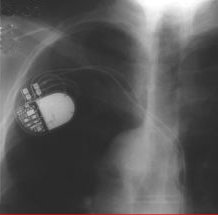 Fowler
Associates Investigates
Fowler
Associates Investigates
Electrostatics
and Pacemakers
"Pacemaker
companies set standards for magnetic and electromagnetic thresholds
for pacemakers. We have investigated the problems with high electrostatic
discharges and pacemaker patients in the workplace."
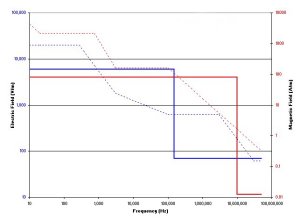 Many
companies require that a survey of the workplace be performed before
an employee who has had a pacemaker implanted can come back to work.
This survey usually only looks at the magnetic (static and dynamic)
fields and at the electromagnetic fields from low frequencies to high
frequencies. The chart shows one pacemaker compay's limits for the workplace
of a pacemaker patient.
Many
companies require that a survey of the workplace be performed before
an employee who has had a pacemaker implanted can come back to work.
This survey usually only looks at the magnetic (static and dynamic)
fields and at the electromagnetic fields from low frequencies to high
frequencies. The chart shows one pacemaker compay's limits for the workplace
of a pacemaker patient.
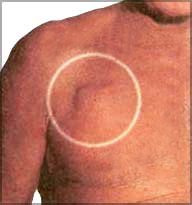 Fowler
Associates not only performs the normal magnetic/EMI surveys, we also
look at the problem of electrostatic discharges (ESD) to the patient.
Normally, ESD is not an issue in most workplaces. However, certain jobs
do give cause for concern. Electrostaic discharges in plastics manufacturing
are of a real concern due to the
Fowler
Associates not only performs the normal magnetic/EMI surveys, we also
look at the problem of electrostatic discharges (ESD) to the patient.
Normally, ESD is not an issue in most workplaces. However, certain jobs
do give cause for concern. Electrostaic discharges in plastics manufacturing
are of a real concern due to the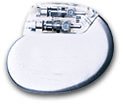 potentially extreme voltages which may be found. In one plant, we investigated
a 3,000,000 Volt discharge to an operators chest area. It was a 911
call. If that operator had been a pacemaker patient, the outcome of
the hospital visit may have been less satisfactory. In one case, a sandblaster
worker took an extreme discharge to his head with disasterous results.
potentially extreme voltages which may be found. In one plant, we investigated
a 3,000,000 Volt discharge to an operators chest area. It was a 911
call. If that operator had been a pacemaker patient, the outcome of
the hospital visit may have been less satisfactory. In one case, a sandblaster
worker took an extreme discharge to his head with disasterous results.
 A
pacemaker is implanted just under the skin of a patient with its leads
connected to the heart tissue in the atrium are of the heart by little
"grappleing hooks" or screws like wires. The pacemaker senses
the heart beats and injects a small amount of energy when needed to
keep the heart rate at a normal pace.
A
pacemaker is implanted just under the skin of a patient with its leads
connected to the heart tissue in the atrium are of the heart by little
"grappleing hooks" or screws like wires. The pacemaker senses
the heart beats and injects a small amount of energy when needed to
keep the heart rate at a normal pace.
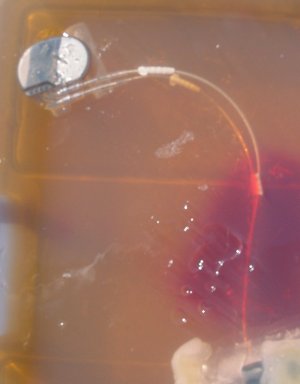 If
very high electrostatic discharges are experienced especially in the
chest area, the pace maker could be damaged, the leads connections could
be affected or the energy of the ESD could cause heart pace problems.
Fowler Associates performed experiments with gellatine phantoms to determine
the amount of energy which could be expected in an extreme ESD condition.
If
very high electrostatic discharges are experienced especially in the
chest area, the pace maker could be damaged, the leads connections could
be affected or the energy of the ESD could cause heart pace problems.
Fowler Associates performed experiments with gellatine phantoms to determine
the amount of energy which could be expected in an extreme ESD condition.
We
found that at 100,000 Volts of ESD to the area of the gelletine just
above the pacemaker, the energy we saw through the leads was on the
order of 1.4 mJoules at a current of 548 mAmperes. If we scale this
up to the 3,000,000 Volt ESD event we investigated, this would give
an energy of 42 mJoules at a current of 16.4 Amperes. This could be
much higher at this extreme potential due to the breakdown of the tissue
between the pacemaker and the skin.
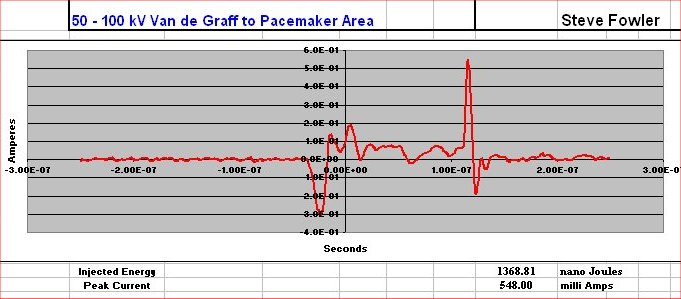
We
believe that the workplace for pacemaker patients returning to work
should be surveyed for ESD hazards. Many of these can be mitigated if
found to be too high and the worker allowed to return to a safe workplace.
Some related Web Articles:

